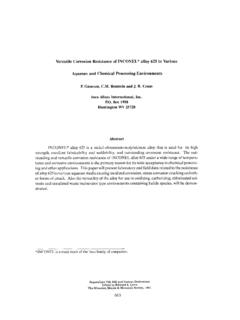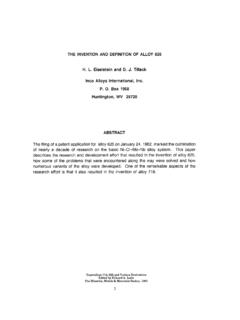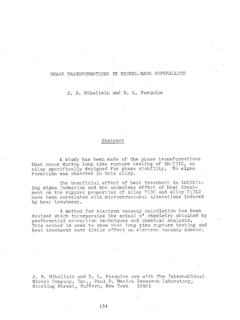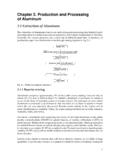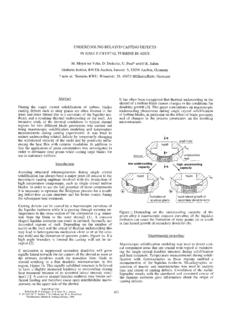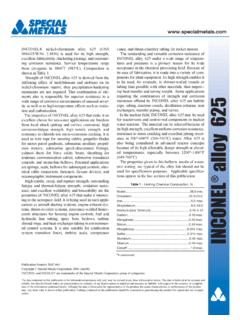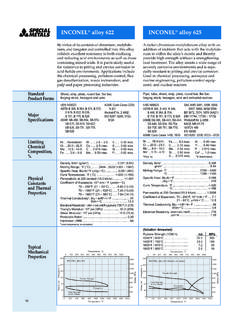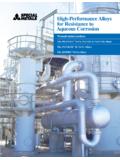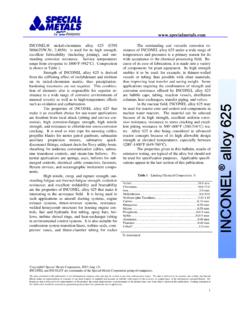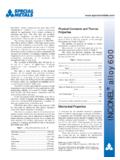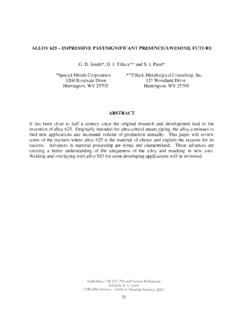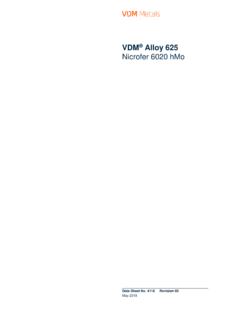Transcription of ALLOYS 625 AND 725: TRENDS IN PROPERTIES …
1 ALLOYS 625 AND 725: TRENDS IN PROPERTIES AND APPLICATIONSL ewis E. Shoemaker Huntington ALLOYS / Special Metals Corporation 3200 Riverside Drive, Huntington, WV, 25705-1771, USA Keywords alloy 625 , UNS N06625, alloy 625 LCF, UNS N06626, Alloy 725, UNS N07725, Metallurgy, TTT Diagram, Precipitation Hardening, Microstructure, Fatigue, Welding, Fasteners, Strength AbstractINCONEL alloy 625 (UNS N06625) has been widely used for over 50 years in the marine and petroleum industries for applications requiring high strength, fracture toughness, fabricability and resistance to corrosion. By increasing the titanium content of the alloy in the presence of its content of niobium, an alloy that can be significantly strengthened by heat treatment is created. By the precipitation of various secondary phases in an austenitic matrix, INCONEL alloy 725 (UNS N07725) offers the high strength of alloy 718 along with the corrosion resistance of alloy 625 .
2 The metallurgy of alloy 725 is discussed along with information about its PROPERTIES , fabrication, and applications. Introduction The official life of INCONEL alloy 625 (UNS N06625) began on December 8, 1964 with the issue of United States Patent Number 3,160,500 to Herbert L. Eiselstein and John Gadbut of the Huntington ALLOYS Products Division of the International Nickel Company in Huntington, West Virginia, USA. The unique PROPERTIES of the new alloy described in the patent were its high tensile strength and resistance to creep and stress rupture at elevated temperatures. However, it has since proven to be a most versatile alloy with a variety of useful PROPERTIES including resistance to corrosion by a wide variety of media including seawater and both oxidizing and reducing acids and salts, high fatigue strength, and excellent weldability and fabricability. Several variations of alloy 625 have been developed offering even more useful PROPERTIES for some specific environments.
3 alloy 625 alloy 625 was developed as a nickel-chromium alloy solid solution strengthened by its content of molybdenum and niobium. It was soon determined that the alloy had two main areas of application .. resistance to aqueous corrosion at ambient to slightly elevated temperatures and for high strength and resistance to creep, rupture, and corrosion at high temperatures. This resulted in the definition of two grades of the alloy that ASTM designated as grades 1 and 2. Grade 1 material is described as annealed and is intended for service up to 1100 F (593 C). *INCONEL is a registered trademark of the Special Metals family of companies. 409 Superalloys 718, 625, 706 and Derivatives 2005 Edited by LoriaTMS (The Minerals, Metals & Materials Society), 2005 These products are normally annealed in the range of 1600 to 1800 F (871 to 982 C) and exhibit a fine grain structure. Grade 2 products aredescribed as solution annealed and are intended for service at temperatures over 1100 F (593 C) when resistance to creep and rupture are needed.
4 While ASTM specifications require a minimum annealing temperature of 2000 F (1093 C), products are normally annealed between 2050 and 2150 F and, thus, exhibit a coarse grain structure. This enhances the alloy s resistance to creep and rupture at high operating temperatures. A recent advancement in the development of alloy 625 -type products is a vacuum induction melted, controlled chemical composition, fine grain product that exhibits greatly improved fatigue resistance and thermal stability. Marketed as alloy 625 LCF, this grade has been issued the UNS number, N06626. Melting is closely controlled to produce a particularly clean microstructure. Thermal-mechanical processing is conducted to produce a fine grain size. This structure results in enhanced resistance to mechanical fatigue (Figure 1) and improved thermal stability. alloy 625 LCF exhibits excellent weldability and is used for fabrication of bellows and structures exposed to cyclic conditions at elevated temperatures.
5 Figure 1 - Relative fatigue resistance alloy 625 and alloy 625 LCF at temperatures of 900 to 1200 F (480 to 650 C) push / pull tests with 5 ksi base stress Precipitation Hardening While alloy 625 was marketed as a solid solution strengthened alloy, with about 4% niobium it was found to be somewhat age hardenable. When heated in the 1200 to 1600 F (649 to 871 C) range, alloy 625 can precipitate a fine Ni3Nb dispersoid, . Various forms of carbide particles (principally M6C) can also form (Figure 2). Recent studies by Radovich indicate that may also form under some conditions. The effect of the combined precipitation of these phases is to significantly increase the yield and tensile strengths of the alloy. Annealed alloy 625 products typically exhibit tensile and yield strength values of 130 ksi and 60 ksi, respectively. However, 410material aged at 1200 to 1250 F (649 to 677 C) for extended periods of time (up to 100 hours) exhibit tensile strength over 160 ksi and yield strength over 110 ksi.
6 Figure 2 - Time-Temperature-Transformation Diagram alloy 625 The age hardening response of alloy 625 was further improved by the addition of titanium to produce a new alloy designated INCONEL alloy 725 (UNS N07725). Alloy 725 exhibits essentially the same chemical composition (Table 1) as alloy 625 except that the titanium content is increased to about to enhance precipitation hardening. Thus, it exhibits the excellent corrosion resistance of alloy 625 . In essence alloy 725 offers the excellent strength PROPERTIES of alloy 718 with the proven corrosion resistance of alloy 625 . The time-temperature transformation diagram for alloy 725 is presented as Figure 3. It is seen that the precipitation contours for alloy 725 are similar to those for alloy 625 except that onset of precipitation of the phase in alloy 725 occurs much more quickly than the precipitation of the phase in alloy 625 .
7 Thus, the aging treatment required for alloy 725 is much more practical from a production standpoint than that for alloy 625 . Table 1 Typical Chemical Composition ALLOYS 625 & 725 Alloy Ni Cr Mo Nb Ti C 625 60 21 9 725 58 21 9 As is seen in Figure 3, in addition to , a second phase, , can also precipitate. It has been shown by Mannen, that this phase has a cumulative effect with in strengthening alloy 725. Figure 4 shows the microstructure of alloy 725 specially heat treated to precipitate both and phases. While the typical yield strength of alloy 725 aged to precipitate only is about 130 ksi, material heat treated to precipitate both and phases, exhibits a typical yield strength level of 145 ksi.
8 411 Figure 3 Time-Temperature-Transformation Diagram Alloy 725 Figure 4 Microstructure of alloy 725 heat treated to induce precipitation of eta phase to further strengthen the alloy matrix. Gamma prime constituent is too small to be seen at this magnification Applications .. alloy 625 alloy 625 which recently celebrated its 50th birthday , has been used for many varied applications. As noted earlier, the alloy offers strength, fatigue resistance, and resistance to aqueous corrosion for ambient to slightly elevated temperature service. And, it also offer strength and resistance to creep, rupture, and hot corrosion (especially oxidation and carburization at elevated temperatures. alloy 625 also maintains good tensile strength, ductility, and impact and toughness PROPERTIES at cryogenic temperatures. alloy 625 offers excellent weldability and resistance to hot cracking.)
9 Thus it has become a quite popular welding composition. 412It is known that chromium imparts resistance to attack by oxidizing acids ( , nitric acid) and salts ( , ferric and cupric chloride) to nickel-base ALLOYS . It is also known that molybdenum and niobium (and to a lesser extent, chromium) help define an alloy s resistance to attack by reducing acids ( , sulfuric and hydrochloric acids). With 22% chromium, 9% molybdenum and niobium, alloy 625 offers excellent resistance to both reducing, oxidizing, and mixed media. It also provides particularly good resistance to marine corrosion. Thus, alloy 625 (grade 1) is widely used for fabrication of shipboard components and associated support hardware. alloy 625 also offers PROPERTIES that make it attractive for service at elevated temperatures. Chromium is the key element in giving a nickel-base alloy its resistance to corrosive attack at elevated temperatures ( , oxidation, carburization, and sulfidation).
10 Molybdenum and niobium are especially effective in their role of strengthening an alloy at elevated temperatures. Thus, alloy 625 (grade 2) offers a desirable combination of strength and creep and rupture resistance along with resistance to corrosive attack at service temperatures up to about 2100 F (1140 C). alloy 625 is one of the few ALLOYS manufactured today for which the ASME Boiler and Pressure Vessel Code has defined allowable design stresses for service up to 1800 F (982 C). The recuperator on the AGT 1500 gas turbine of the US M1 Abrams tank (Figure 5) has consumed large tonnages of alloy 625 over the past twenty years. The recuperator uses the heat from the engine exhaust to heat inlet air to 1000 F (538 C). The system operates under a pressure of about 200 psi (1,350 Mpa) so any through-wall cracks would allow pressurized air to escape thereby reducing the amount of preheated air available to the engine and decreasing its overall efficiency.
